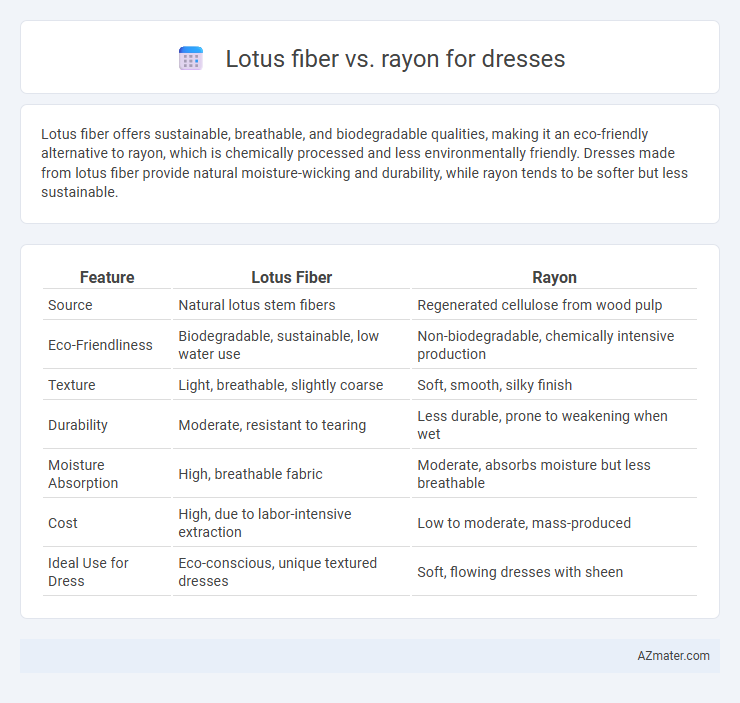Lotus fiber offers sustainable, breathable, and biodegradable qualities, making it an eco-friendly alternative to rayon, which is chemically processed and less environmentally friendly. Dresses made from lotus fiber provide natural moisture-wicking and durability, while rayon tends to be softer but less sustainable.
Table of Comparison
| Feature | Lotus Fiber | Rayon |
|---|---|---|
| Source | Natural lotus stem fibers | Regenerated cellulose from wood pulp |
| Eco-Friendliness | Biodegradable, sustainable, low water use | Non-biodegradable, chemically intensive production |
| Texture | Light, breathable, slightly coarse | Soft, smooth, silky finish |
| Durability | Moderate, resistant to tearing | Less durable, prone to weakening when wet |
| Moisture Absorption | High, breathable fabric | Moderate, absorbs moisture but less breathable |
| Cost | High, due to labor-intensive extraction | Low to moderate, mass-produced |
| Ideal Use for Dress | Eco-conscious, unique textured dresses | Soft, flowing dresses with sheen |
Introduction to Lotus Fiber and Rayon
Lotus fiber, derived from the stems of lotus plants, offers a sustainable and eco-friendly alternative for dress materials, known for its lightweight texture and natural antibacterial properties. Rayon, a semi-synthetic fiber produced from cellulose, delivers a smooth, breathable fabric favored for its versatility and affordability in fashion. While lotus fiber emphasizes environmental sustainability and uniqueness, rayon remains popular for its ease of dyeing and fabric softness in dressmaking.
Origins and Production Processes
Lotus fiber, derived from the stems of the lotus plant primarily found in Southeast Asia, involves a labor-intensive extraction process where fibers are hand-cut, soaked, and sun-dried, resulting in a rare, eco-friendly textile. Rayon, a semi-synthetic fiber made from cellulose extracted mainly from wood pulp, undergoes chemical treatment and spinning processes to create a versatile and cost-effective fabric. The natural and sustainable origins of lotus fiber contrast with rayon's chemically processed production, influencing their environmental impact and fabric characteristics.
Environmental Impact: Sustainability Comparison
Lotus fiber is a highly sustainable material derived from the lotus plant, requiring minimal water and pesticides during cultivation, making it an eco-friendly alternative to rayon, which is typically produced from chemically processed wood pulp. The production of lotus fiber involves biodegradable and non-toxic methods, significantly reducing pollution compared to rayon's energy-intensive and chemically hazardous manufacturing process. Lotus fiber's biodegradability and renewable sourcing contribute to a lower environmental footprint, positioning it as a greener choice for environmentally conscious dress materials.
Fabric Texture and Feel
Lotus fiber offers a unique, natural texture that is lightweight, breathable, and slightly coarse, providing an earthy and rustic feel ideal for eco-conscious fashion. Rayon, made from cellulose fibers, has a smooth, silky texture with excellent drape and softness, making it preferable for flowing, elegant dresses. When choosing fabric, lotus fiber delivers durability and natural ventilation, while rayon emphasizes comfort and a luxurious hand feel.
Breathability and Comfort
Lotus fiber offers superior breathability compared to rayon due to its natural hollow structure, which allows better air circulation and moisture absorption, making it ideal for hot and humid climates. Rayon, while soft and smooth, tends to retain heat and moisture, which can reduce overall comfort during prolonged wear. Choosing lotus fiber for dresses ensures enhanced ventilation and a cooler, more comfortable experience.
Durability and Longevity
Lotus fiber offers exceptional durability and longevity due to its natural strength and resistance to wear, making it ideal for high-quality dresses that maintain their shape over time. Rayon, while soft and versatile, tends to be less durable and more prone to damage from moisture and abrasion, resulting in shorter garment lifespan. Choosing lotus fiber ensures a sustainable, long-lasting dress that withstands regular use better than rayon counterparts.
Color Retention and Dyeing Qualities
Lotus fiber exhibits excellent color retention due to its natural cellulose structure, allowing dyes to bond deeply and maintain vibrancy over time, making it ideal for dresses requiring longevity in color. Rayon, being a semi-synthetic fiber derived from cellulose, also absorbs dyes well but tends to fade faster with repeated washing and exposure to sunlight. The superior dyeing qualities of lotus fiber result in richer, more durable hues compared to the relatively quicker color dulling seen in rayon fabrics.
Pricing and Market Availability
Lotus fiber garments typically command higher prices due to the labor-intensive extraction process and limited supply, making them a luxury niche in the textile market. Rayon, widely produced from regenerated cellulose, offers affordability and mass availability, dominating mainstream dress fabric options. Market availability for lotus fiber remains restricted primarily to artisanal and eco-conscious brands, whereas rayon is readily accessible across global fashion retailers.
Suitability for Dresses and Fashion Trends
Lotus fiber offers exceptional breathability, natural sheen, and eco-friendly qualities, making it highly suitable for lightweight, summer dresses favored in sustainable fashion trends. Rayon, known for its smooth texture and drape, remains popular for elegant, flowing dresses but has environmental challenges due to its chemical-intensive production. The increasing demand for eco-conscious fabrics is driving designers to prefer lotus fiber in contemporary dress collections over traditional rayon options.
Final Verdict: Which is Better for Dresses?
Lotus fiber offers superior breathability, natural moisture-wicking, and eco-friendly properties compared to rayon, making it ideal for comfortable, sustainable dresses. Rayon provides a smooth texture and vibrant drape but involves chemical processing that impacts environmental sustainability. For dresses, lotus fiber is better suited due to its durability, biodegradability, and luxurious feel that aligns with eco-conscious fashion choices.

Infographic: Lotus fiber vs Rayon for Dress
 azmater.com
azmater.com